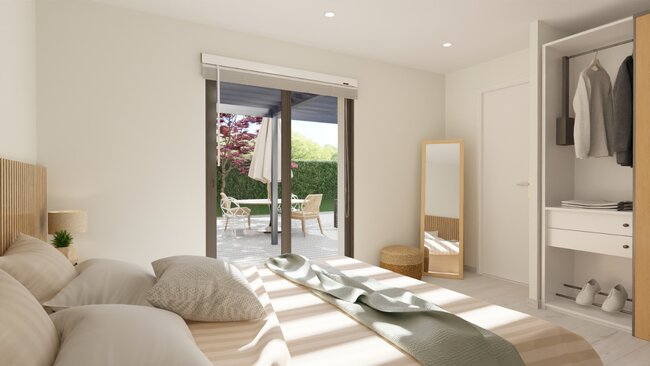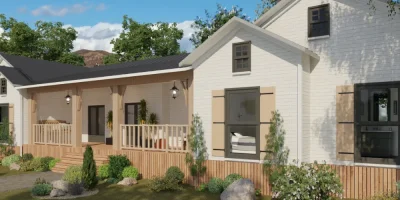When designed right, basements can bring immense value and function to your client’s home.
But at first glance, basements can be tricky and easily turn into a catch-all dumping ground for anything and everything. Between layout, accessibility, and daily function, it takes a smart approach to make the most of these spaces, especially when they’re on the smaller size.
Your clients don’t need a large basement to get good use out of it. Today, we’ll review small basement design ideas to spur your creativity and help your clients get the space of their dreams.
Common Basement Living Space Layouts
Before diving into the design, it’s important to understand the different types of basement layouts you might encounter:
- Walkout Basement: This type has one or more full-size doors that open directly to the outside, usually at ground level. It’s ideal for maximizing natural light and creating a seamless indoor-outdoor flow.

- Daylight Basement: Similar to a walkout basement, but instead of full doors, it features larger windows that allow significant natural light to enter.

- Standard Basement: This is fully underground with small windows near the ceiling. While it offers less natural light, it provides excellent insulation and can be a cozy retreat.

- Split-Level Basement: In this layout, the basement is partially above ground, often with its own entrance and larger windows than a standard basement.

Understanding these layouts will help you determine the best design approach for your client’s specific basement type.
8 Small Basement Design Ideas
Now, let’s explore some creative ways to maximize space in a small basement. Remember, the key is to create a basement that will work for your client’s specific needs and lifestyle, so be sure to customize these for their situation.
Divide Space with Sliding Doors
In a small basement, flexibility is crucial. Sliding doors or room dividers can create multi-purpose spaces that adapt to your client’s changing needs. For example, a large open area could be divided into a home office during the day and a guest room at night.

Key Considerations:
- Choose lightweight, easy-to-move dividers to maintain the feeling of openness.
- Consider using frosted glass dividers to allow light to pass through while maintaining privacy.
- Ensure the tracking system for sliding doors doesn’t impede on headroom.
Use it as a Guest Bedroom
A basement guest room can provide visitors with privacy and comfort without disrupting the main living areas of the home. Bright, airy colors with good lighting can make the space feel inviting, even if there’s not as much natural light to work with.
Consider using a Murphy bed or sofa to allow the space to serve multiple purposes when your clients aren’t hosting.

Provide a Playroom for Kids
Your clients can stop tripping on legos or finding stuffed animals buried in the living room couch cushions if they consider turning their small basement into a dedicated playroom for their kids. Doing so serves many purposes, like clutter and noise management, freeing up the main living areas.
If you pitch this route, use durable,easy-to-clean flooring and wall finishes, incorporate plenty of storage solutions for toys and games. You might also suggest adding pops of color to create a fun, vibrant space.

Make it a Home Office
It’s likely that your clients will ask about the potential for a home office. To not take away space from the main living area, consider converting their small basement into a home office instead. This could be beneficial for a private area with minimal distractions as compared to the upstairs levels.
In your design be sure to prioritize:
- Good lighting, both natural (if possible) and artificial.
- Adequate electrical outlets for office equipment.
- Strong internet and cell phone reception.

Use It As Organized Storage Space
When people think about the use-case for basements, their minds often go to storage. And, with the right solution, that can be an excellent way to make the most of that space.
When working with a small basement, you’ll need to get creative with your storage approach, like using the vertical space with tall shelving units or implementing an organizational system with labeled bins or boxes.
As you’re designing, remember to leave clear pathways for easy access in, out, and through the storage area.
Plus, the whole basement doesn’t need to be dedicated to storage. You can bring in the sliding door or partition concept to give the space a dual purpose.
Store & Display Collectables
Does your client have a nice set of jerseys from their favorite sports team? Vintage furniture? What about a stack of collectible comics, coins, cards, or magazines? A basement can serve as a unique display area for these collectibles.
If you want to design this route, install unique lighting to effectively showcase these items. Think LED strip lights in a cabinet or picture lights above a piece of art.
Should their collectibles require climate control like vintage wine, cigars, or spirits, consider a dedicated place to include those elements like a sealed door as well as temperature and light controlled functionality.
You may also want to consider incorporating secure display cases or shelving appropriate for the collection.
Make it a Game Room
A basement game room can be the perfect spot for entertainment and relaxation. Depending on your client’s preferences, you could take this in so many different directions:
- Theater space with an extra large TV and comfortable seating. You could even include extras like a popcorn maker or vintage vending machine.
- Video game space with ergonomic chairs, fast internet speed for streaming, and several TVs for multi-player options.
- Vintage game room with pinball machines and other classic arcade games.
- Traditional game lounge with a pool table, darts, air hockey, etc.
Plan the layout carefully to accommodate game tables or equipment. Plus, consider soundproofing to minimize noise transfer to the rest of the house.

Create a Studio Apartment
If your client doesn’t need the extra living or storage space, you might pitch that they turn their small basement into a studio apartment.
Converting that space could accommodate multi-generational living (think in-laws or adult children) or possibly provide short-term rental income. This option would likely work best if your clients had a walk-out basement for safety and usability.
Before pitching this, check local zoning laws and building codes for legal requirements. You’ll also want to ensure proper egress, ventilation, and natural light.

Start Designing Your Basement Today!
Now that we’ve explored these creative small basement design ideas, it’s time to bring them to life with basement floor plan designs using Cedreo.

Our floor plan tools make it easy to account for the unique challenges of basement spaces, such as low ceilings or support columns with drag and drop modules.
With this tool, you can design your basement in minutes and even transform it into a 3D rendering for a realistic visualization perfect for client presentations and design meetings.
By leveraging Cedreo’s capabilities, you can streamline your design process, impress your clients with professional presentations, and ultimately, bring more basement transformation projects to life.
Remember, a well-designed small basement can add significant value to a home. With creativity, careful planning, and the right tools, you can help your clients make the most of every square foot of their basement space.
Check out Cedreo today and elevate your basement design game!



